-
The Future of Medical Cannabis: Trends to Watch
Medical cannabis has come a long way since it was first introduced as a treatment option for various ailments. Once a controversial topic, it has now gained widespread acceptance in many parts of the world. This article explores the future of medical cannabis, highlighting key trends that are likely to shape its growth and impact over the next decade.
Overview of Medical Cannabis
Medical cannabis, often referred to as medicinal marijuana, is derived from the Cannabis sativa plant and is used to treat a variety of medical conditions. It has been used for centuries, dating back to ancient civilizations that utilized cannabis for pain relief, anxiety, and even as an anesthetic. Today, it’s primarily used to treat chronic pain, mental health issues, epilepsy, and other neurological conditions.
See more: Terpenes in Medical Marijuana: An Overview
Cannabis contains compounds known as cannabinoids, primarily THC (tetrahydrocannabinol) and CBD (cannabidiol), which interact with the body’s endocannabinoid system to produce therapeutic effects. THC is the psychoactive compound responsible for the “high” associated with marijuana, while CBD is non-psychoactive and is credited with various medicinal benefits, including anti-inflammatory and anti-anxiety properties.
Evolving Legal Landscape
The legal status of medical cannabis is rapidly changing worldwide. Over the past few years, many countries and states have shifted their stance, legalizing cannabis for medical use. In the United States, for example, over 30 states have legalized medical cannabis, though it remains illegal at the federal level. Similarly, countries like Canada and Uruguay have fully legalized cannabis, while others, such as Germany and the Netherlands, have adopted more restrictive policies, allowing cannabis use only for certain medical conditions.
Despite the growing acceptance, the global legal landscape remains inconsistent, and this presents challenges for both patients and healthcare providers. Some regions are still grappling with how to regulate medical cannabis effectively, balancing public health concerns with the demand for treatment. As regulations evolve, countries must navigate issues like prescribing standards, quality control, and accessibility to ensure patient safety.
Technological Innovations
Technological advancements are playing a significant role in improving the effectiveness of medical cannabis. One of the most significant innovations is the development of more refined extraction methods. Today, cannabis is processed into a variety of product forms, including oils, tinctures, capsules, edibles, and vapes. Each method offers different bioavailability rates and benefits, enabling patients to choose the one that best suits their needs.
Cultivation techniques have also evolved, with growers using advanced technologies like hydroponics and vertical farming to produce high-quality cannabis more efficiently. These innovations help meet the increasing demand for medical cannabis while ensuring consistency and potency in the final product. As the industry matures, we can expect even more sophisticated methods of cultivation and product formulation that will enhance the efficacy and accessibility of medical cannabis.
Medical Research and Clinical Trials
Ongoing research and clinical trials are crucial to understanding the full potential of medical cannabis. Scientists are continuously studying its effects on a range of conditions, from chronic pain to mental health disorders like anxiety and depression. Recent studies have shown promising results for cannabis in managing pain, reducing inflammation, and improving quality of life for patients with conditions like multiple sclerosis and Parkinson’s disease.

As more clinical trials are conducted, we can expect a deeper understanding of cannabis’s therapeutic applications. Researchers are particularly focused on how cannabis interacts with other treatments, such as chemotherapy, and how it may enhance or support conventional medical therapies. With the growing body of evidence supporting its use, medical cannabis could become a mainstream treatment option for a variety of conditions in the near future.
Integration into Mainstream Healthcare
One of the most exciting trends is the integration of medical cannabis into mainstream healthcare. As more doctors gain knowledge and confidence in prescribing cannabis-based treatments, we are likely to see its increased use in hospitals, pain management centers, and specialized clinics. The stigma surrounding cannabis is gradually fading, allowing healthcare professionals to consider it as a legitimate treatment option alongside other therapies.
Several states and countries have already seen success with medical cannabis programs, and many healthcare providers are now offering cannabis consultations to patients. This integration is not without challenges, though, particularly when it comes to training medical professionals and establishing clear guidelines for use. However, as more evidence accumulates and patient experiences demonstrate its efficacy, medical cannabis is poised to become a standard treatment for many conditions.
Consumer Trends and Market Growth
The demand for medical cannabis is growing rapidly, driven by increased public awareness and the expanding body of research supporting its use. Consumers are seeking alternative treatments for conditions that traditional medicine has struggled to address. This has led to a boom in the cannabis market, with new companies entering the industry every year. These businesses are not just selling cannabis; they are also developing new products designed to enhance the patient experience, such as cannabis-infused topicals, edibles, and wellness supplements.
The growing acceptance of medical cannabis has also led to significant investments in the industry, with venture capitalists and healthcare companies eager to tap into this emerging market. The market for medical cannabis is expected to continue growing, and as more countries legalize and regulate cannabis, the global market will likely expand even further.
Future Outlook
Looking ahead, the future of medical cannabis is bright. With ongoing advancements in research, technology, and legal reform, medical cannabis is poised to become an essential part of the healthcare landscape. We can expect increased access to cannabis-based treatments, advancements in product formulations, and more robust evidence supporting its use in clinical settings.
As the medical community continues to embrace cannabis as a viable treatment option, we may see it integrated into a wider range of healthcare services. For patients, this means better access to alternative therapies that can improve their quality of life, particularly for those with chronic conditions or those who haven’t found success with conventional treatments.
In conclusion, the future of medical cannabis looks promising. With its potential to revolutionize healthcare, treat a wide range of conditions, and offer a safer alternative to opioids and other pharmaceuticals, medical cannabis is set to play a significant role in the future of medicine. As the industry continues to evolve, patients, healthcare providers, and researchers alike will benefit from the growing body of knowledge and the expanding availability of cannabis-based therapies.
-
Reasons Why You Shouldn’t Ignore Ovulation Cramps
The reproductive process would not be complete without ovulation. Although some women may not experience any discomfort during ovulation, it can be quite excruciating for others.
Ovulation discomfort is a normal symptom and shouldn’t be ignored unless it’s accompanied by other symptoms that make you worried, especially persistent chronic pain. What you need to know is as follows.
Ovulation Pain: The Essentials
Pain during ovulation is usually mild and short-lived. On the day you think you might be ovulating; you can have pain on one side of your body for a few minutes or perhaps a couple of hours.
As a surge of luteinizing hormone (LH) travels through your system, a follicular cyst swells and eventually ruptures, releasing the egg.

The fallopian tube shortens after the egg is released, allowing it to more easily reach the sperm that are waiting to fertilize it. While this is happening, blood and other fluids from the damaged follicle may leak into the abdominal cavity and pelvis, causing irritation.
The pain might be intense or dull, or anything in between. Discharge, such as spotting, is a possible side effect. Please see a doctor if the pain persists or if it occurs at other times of your cycle.
Other Causes of Period Pain
It’s possible that the discomfort you’re feeling during your period is being caused by something than your period.
Take note of when and where the pain occurs, how long it lasts, and any other symptoms it may bring on. Keeping track of your symptoms can aid you and your doctor in identifying the source of the problem.
It’s best to see a doctor if your midcycle pain persists so that he or she can run diagnostics and prescribe appropriate medication.
Cysts
Ovarian cysts can induce a wide range of uncomfortable side effects, including but not limited to abdominal pain, nausea, and bloating. Cysts might vary in their ability to produce symptoms.

Other, less common cyst types that might cause discomfort include dermoid cysts, cystadenomas, and endometrial cysts.
Ovarian cysts, or polycystic ovarian syndrome (PCOS), are the defining feature of a separate disorder. Infertility can develop in women with PCOS if the condition is left untreated.
A CT scan, MRI, or ultrasound may be ordered by your doctor to help identify the sort of cyst you have. Cysts often disappear on their own without the need for treatment.
Cysts are usually harmless, but they might cause problems if they enlarge or are atypical.
Adhesions or Endometriosis
In the painful condition of endometriosis, tissue that looks like the uterine lining grows in places outside the uterus.
In response to your hormones, the lining tissue of your uterus can become inflamed and bleed or inflame the surrounding area. You may have increased discomfort during your period if you have scar tissue or endometriosis adhesions.
Similarly, prior surgical procedures increase your risk of developing intrauterine adhesions, also called Asherman syndrome. Cesarean section or dilation and curettage (D&C) are examples of such procedures.
These adhesions can also be the result of a previous uterine infection. It is also possible to develop Asherman syndrome for no apparent reason.
Your doctor may recommend a hysteroscopy or laparoscopy if he or she suspects one of these disorders, as they won’t show up on a standard ultrasound. These are operations that provide a clear view into the pelvic or uterine cavity for the clinician.
Disease Spread or the Emergence of STDs (STIs)
Does your discomfort coincide with a discharge that seems abnormal or smells bad? Are you running a fever? Does it hurt when you have to urinate?
These signs may indicate a serious bacterial illness or a sexually transmitted infection (STI) that requires immediate medical attention.
Infections can be caused by medical treatments, including childbirth. Even if you don’t have a urinary tract infection (UTI), you could be experiencing pelvic pain.
Condom use prevents the spread of sexually transmitted diseases such chlamydia, gonorrhea, and HPV.
Ectopic Pregnancy
Signs of an ectopic pregnancy include pain in only one side of the pelvis.
It’s a situation where an embryo implants somewhere other than the uterus, most commonly the fallopian tubes. There is a high mortality rate associated with ectopic pregnancies, and they are often identified by the eighth week.

You should consult a doctor right away if you have any suspicions that you could be pregnant. The rupture of the fallopian tube can be avoided with prompt medical attention and/or surgical removal of the pregnancy if it is discovered to be ectopic.
Managing Chronic Pain During Ovulation
If you’ve seen a doctor and they’ve ruled out anything serious, the pain you’re feeling is probably just regular ovulation discomfort. Please keep a close eye on your symptoms and report any changes to your doctor.
If you’re experiencing midcycle pain, try these strategies to relieve pain:
- Ibuprofen (Advil, Motrin, Midol) and naproxen are examples of OTC pain medicines you can try for pain relief.
- You can also discuss birth control with your doctor, if it’s a desire.
- You can use a heating pad on the region or simply soak in hot water.
If your ovulation pain doesn’t go away, it’s time to see a doctor.
Women between the ages of 21 and 29 are encouraged to get a Pap smear every three years in order to screen for cervical cancer, as recommended by the American College of Obstetricians and Gynecologists (ACOG).
Women between the ages of 30 and 65 should get a Pap smear every 3 years or a Pap smear plus an HPV test every 5 years, according to ACOG guidelines.
Cervical screening is not recommended for women over 65 unless they have a history of the following, according to ACOG guidelines:
All women of childbearing age should see a gynecologist once a year for a checkup and pelvic exam, as well as to discuss any other issues related to their reproductive health.
Annual checkups are advised, while a Pap smear may not be necessary every time. Call your doctor right away if you’ve been experiencing any pain or other symptoms and you haven’t already scheduled an appointment.
Summary
Midcycle cramps are a common symptom of ovulation for women who menstruate. Pelvic pain can also be caused by a number of different disorders, some of which can be quite serious if left untreated.
Always keep a close eye on your physical state and let your doctor know if you notice any changes.
Finally
For more information on chronic pain management, pain disorders, chronic pain resources, psychogenic pain, effective chronic pain treatment options or other physical therapy, you should book a consultation session with a specialist at Chronic Therapy today, to give you professional advice that will suit your personal experience.
Also, for people with chronic pain who are constantly worried on how to treat chronic pain or get their chronic pain treated, our specialist at Chronic Therapy have made huge success over the year in recommending reliable resources to manage chronic pain from nerve pain or any other developing chronic pain conditions.
-
Causes of Painful Urination
Dysuria, or pain during urination, is a catchall name for a variety of symptoms related to urination accompanied by chronic pain. The bladder, urethra, or perineum could be the source of the discomfort. Urine exits the body through a channel called the urethra.
The perineum refers to the area between the penis and the anus in humans. The perineum is the skin that lines the vagina between the anus and the vaginal opening.
Chronic urethral pain is extremely common. Multiple medical diseases can cause pain, burning, or stinging. and there are proven strategies for people that chronic pain affect.
See also: Reasons Why You Shouldn’t Ignore Ovulation Cramps
Why Would Urinating Hurt?
Bladder and Kidney Infections
A urinary tract infection is often characterized by painful urination (UTI). Bacterial infection is a possible cause of a UTI. Urinary tract infection and inflammation are also possible causes.

Your urinary system consists of your urethra, bladder, ureters, and kidneys. It is the ureters’ job to transport urine from the kidneys to the bladder. Urethral, prostate, or kidney inflammation can all contribute to uncomfortable urination.
It’s more common for persons with a vagina to get UTIs than it is for those with a penis. This is because those who have a vagina typically have a shorter urethra. Bacteria can reach the bladder more quickly if the urethra is shorter.
In addition to women, people going through pregnancy or menopause are also more likely to get a urinary tract infection.
Sexually Transmitted Infections (STIs)
If you have a sexually transmitted infection, you may also have pain when peeing (STI). Genital herpes, gonorrhea, and chlamydia are some STIs that can lead to painful urination.

Due to the fact that some STIs do not produce noticeable symptoms, it is crucial to get tested for them. There is a need for widespread STI testing among sexually active individuals.
Prostatitis
However, there are a variety of other medical issues that might make urinating uncomfortable. Prostatitis causes discomfort during urinating in people who have a prostate. The prostate gland has been inflamed and thus this ailment exists. It’s a common source of urinary irritation and burning.
Cystitis
Cystitis, or inflammation of the bladder lining, is another potential cause of painful urination. One of the names for interstitial cystitis (IC) is painful bladder syndrome. Typical cystitis is extremely common. Signs of IC include pelvic and bladder pain and soreness.
Bladder and urinary pain have been reported in patients undergoing radiation therapy. Radiation cystitis is the medical term for this problem.
Urethritis
When the urethra becomes inflamed, a condition called urethritis occurs. Urethritis is characterized by urinary discomfort and an increased need to pee.
Epididymitis
If you have a penis and are experiencing painful urination, you may be suffering from epididymitis, an inflammation of the epididymis. The epididymis, which sits behind the testicles, is responsible for the transportation and storage of sperm.
Pelvis Inflammatory Disease (PID)
The cervix, uterus, ovaries, and fallopian tubes can all be impacted by PID. Its symptoms include, but are not limited to, abdominal discomfort, sex pain, and urination pain.
PID is a life-threatening condition that begins with a bacterial vaginal infection and spreads to the ovaries and uterus.
Debilitating Uropathy caused by Obstruction
Urine reflux into the kidneys is a symptom of obstructive uropathy, which can be caused by a blockage in the ureter, the bladder, or the urethra. Although there may be many potential causes, it is critical to get medical attention if you experience any of the following symptoms.
Similar problems with urination and pain can be brought on by urethral stricture, in which the urethra becomes abnormally narrowed.
Urinary Calculi
If you suffer from kidney stones, you may experience discomfort when attempting to urinate. Stones in the kidneys are solid masses that form in the urine system.
Medications
A painful urination is a side effect of various drugs, including cancer treatments and some antibiotics. If you’re experiencing negative reactions to any medications you’re taking, be sure to tell your doctor.
Personal Care Items
Infection isn’t always the cause of painful urination. Products used in the vaginal area have also been linked to this condition. Vaginal tissues are especially vulnerable to irritation from soaps, lotions, and bubble baths.
In addition to causing irritation and painful urination, dyes included in laundry detergents and other toiletry products can be a source of discomfort.

Managing Chronic Pain During Urination
The initial stage in pain treatment will be to identify the source of the discomfort. Urinary discomfort can be treated with medicines prescribed by your doctor. UTIs, bacterial infections, and certain STIs can all be treated with antibiotics. Medications to soothe an inflamed bladder may be prescribed by your doctor.
In most cases, the pain associated with urinating due to a bacterial infection subsides soon after treatment begins. You should always follow your doctor’s instructions when taking medication.
Infections like interstitial cystitis can cause severe pain that can be difficult to manage. Drug treatments could take longer to show results. Up to four months of drug use may be required before you begin to feel better.
You can find some relief from your symptoms by making certain adjustments to your way of life. To lessen the possibility of irritation, you should avoid using scented cleaning products and personal care items.
When engaging in sexual activity, it is recommended that you use a condom or another reliable barrier device. The bladder can be irritated by certain meals and drinks, so it’s best to avoid them (such as highly acidic foods, caffeine, and alcohol).
Keep your fluid intake up.
When to Visit the Doctor to Relieve Pain
Get in touch with your local health care provider:
- If you’re pregnant and experiencing severe, prolonged pain, you may also be running a temperature.
- if you have pain passing a bladder or kidney stone if your urine has a strange odor, blood, or is hazy if the pain is accompanied by stomach distress
- The source of the discomfort can be determined by answering questions and submitting lab work requested by your doctor.
Finally
For more information on chronic pain management, pain disorders, chronic pain resources, psychogenic pain, effective chronic pain treatment options or other physical therapy, you should book a consultation session with a specialist at Chronic Therapy today, to give you professional advice that will suit your personal experience.
Also, for people with chronic pain who are constantly worried on how to treat chronic pain or get their chronic pain treated, our specialist at Chronic Therapy have made huge success over the year in recommending reliable resources to manage chronic pain from nerve pain or any other developing chronic pain conditions.








